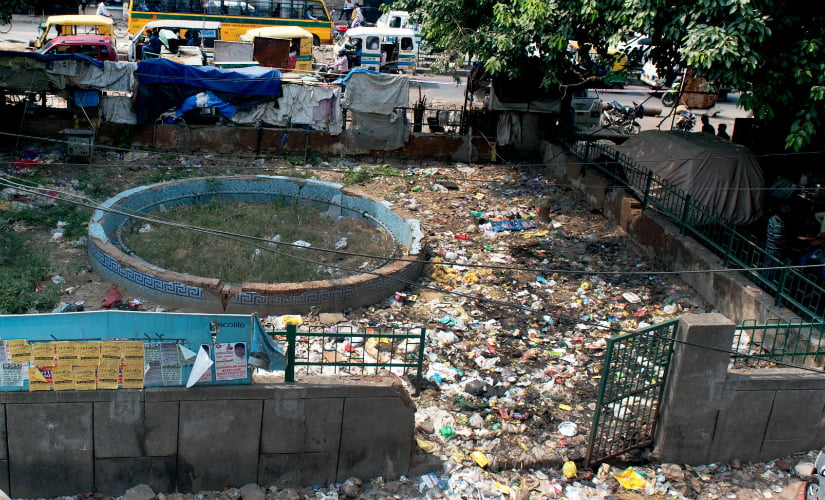
According to a recent study report prepared by ‘Centre for Civil Society’, Municipal Corporations in Delhi were unable to utilise funds allocated under the Centre’s Swachh Bharat Mission with the North Delhi Municipal Corporation (NDMC) “failing” to spend a single penny out of the Rs 46.28 crore allocated to it.
Firstpost visited different localities of north, south and east Delhi and found dumped garbage and filth in residential and commercial areas that’s best described in pictures. The apathy of Municipal Corporations of Delhi (MCDs) was glaring.
Community park at a local market in Govindpuri

A bird’s eye view of a community park at a local market in Govindpuri, South East Delhi, which has long been turned into a garbage dumping site. (Photos: Debobrat Ghose and Naresh Sharma )
A trader in the local Govindpuri market said that the local traders’ association has several times pleaded with the MCD to clean this area, but they are not bothered. “We were told that the other side of this lane falls under the jurisdiction of NDMC, so MCD South can’t interfere. We don’t know how true it is. Here there are so many food stalls by the roadside and it’s so unhygienic. When it rains, it becomes impossible to work here due to its foul odour,” he complains.
Garbage dumped by the roadside at Hasanpur in Patparganj

Garbage dumped from adjoining localities has been lying for weeks by the roadside at Hasanpur in Patparganj. The spot is hardly 50 meter from Max Super Speciality Hospital, and State Bank of Travancore branch in Patparganj. (Photos: Debobrat Ghose and Naresh Sharma)
Sikandar, a resident of Hasanpur at Patparganj in East Delhi says, “A member of my family has been suffering from dengue. We’ve requested the civic body workers several times to clean the place and not to dump garbage here. But, no one listens. Our local MLA never visited to take a stock of the situation. It has become impossible to live in this area due to stench emanating from the garbage, with flies and mosquitoes all around. Even hospital waste is dumped here.”
Garbage dump at Okhla, a suburban colony in south Delhi

The garbage dump at Okhla, a suburban colony in south Delhi which is also known for its industrial estate. (Photos: Debobrat Ghose and Naresh Sharma)
Garbage dump at Karawal Nagar in North East Delhi

Garbage dump at Karawal Nagar. (Photos: Debobrat Ghose and Naresh Sharma)
It has become painful for the residents of Karawal Nagar in North East Delhi to walk on the road due to stench emanating from the filth and clogged drains.
This sight is common in east Delhi’s Mayur Vihar

One of the colonies of Mayur Vihar in east Delhi.
“Despite being an organised locality, dumped garbage by the roadside is common in many areas. It gets worst during rains,” says Ranjith Nair, a resident of Mayur Vihar.
Residential colony at Satbari

A residential colony at Satbari, close to posh Chattarpur farms in south Delhi. (Photos: Debobrat Ghose and Naresh Sharma)
According to Section 42 of Delhi Municipal Corporation Act 1957, “The obligatory functions of the municipal corporations are the construction, maintenance and cleansing of drains and drainage works and of public latrines, urinals and similar conveniences; scavenging, removal and disposal of filth, rubbish and other obnoxious or polluted matters; reclamation of unhealthy localities, the removal of noxious vegetation and generally the abatement of all nuisances; measures for preventing and checking the spread of dangerous diseases; lighting, watering, and cleansing of public streets and other public places.”
[Source:-F. I ndia]



